Top News
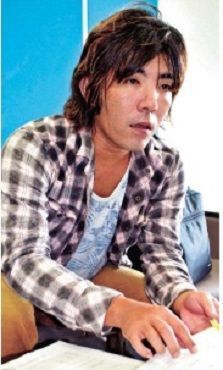
September 16, 2017 Ryukyu Shimpo
Two U.S. servicemen robbed and beat a taxi driver on January 7, 2008 in Mihara, Okinawa City.
Although it has been more than nine years since the incident, on September 15 this year it came to light that reparations have not yet been paid to the victim of the crime.
According to the Okinawa Defense Bureau (ODB), this is because the Japanese government’s examination regarding compensation is still ongoing.
The taxi driver’s lawyer Tsutomu Arakaki says that this progress is “excessively slow.”
He thinks that the ODB is not sufficiently attentive toward helping his client.
The perpetrators of this crime were a U.S. Marine corporal and another young serviceman.
At the time of the incident they were 20 and 19 years old, respectively.
While stealing the taxi driver’s cash they assaulted him with an alcohol bottle, causing lacerations on his head and spraining his neck.
The two servicemen were arrested on the charges of robbery and inflicting injury, were indicted, and both received prison sentences.
According to the victim’s eldest son, 32-year-old Muneyuki Ura, his father suffered from PTSD.
In 2012 his father died from illness, with reparations to him still unpaid.
On September 12, Muneyuki submitted a written inquiry to the ODB.
According to the ODB’s reply on September 15, the victim’s representing lawyer submitted letters demanding damages be paid on five occasions between May 2009 and October 2014.
The damages demanded in these letters totaled around 22,500,000 yen (about 225,000 USD).
In the case of U.S. servicemen causing incidents while off-duty, should the perpetrators be unable to make a settlement outside of court, the ODB will examine the victim’s claims and produce a written report. The U.S. government will then review the report and decide on the amount of consolation money to be paid.
The 1996 Special Action Committee on Okinawa (SACO) agreement established that should the consolation sum decided by the U.S. government be less than the sum of damages determined in the Japanese civil suit, the Japanese government will be in the position to pay the difference.
However, the ODB’s reply to Muneyuki noted that in order to calculate damages, the ODB needs specific confirmation of the victim’s condition, and has been waiting for medical institution-provided diagnoses.
Its reply also noted that at the time the ODB indicated to the victim’s lawyer which medical certificates the bureau lacked, and had requested that the lawyer submit this documentation.
The ODB explained that the Japanese government’s examination is ongoing.
Arakaki, the victim’s lawyer, said that in the claims he has been involved with, “Normally [damages] are paid within two years.
” Speaking about the ODB requesting medical papers, he also said: “It would be one thing if [the victim] was still undergoing treatment, but upon his death the ODB should have conducted its own investigation.”
Muneyuki said: “My father was concerned about the unpaid reparations until the end.
How long does he have to wait?”
(English translation by T&CT and Erin Jones)
Go to Japanese
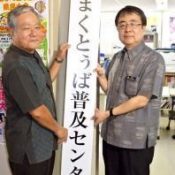
September 13, 2017 Ryukyu Shimpo
On August 12, the Okinawa Prefectural Government (OPG) held an opening ceremony for the “Shimakutuba Promotion Center,” which plays a core role in encouraging the use of Shimakutuba, at the OPGʻs Culture Promotion Division.
The Prefectural Cultural Association manages the Center, consisting of a part-time director and four full-time staff.
Professor Emeritus of the Prefectural University of Arts Eikichi Hateruma acts as the Directer of the Center. The Center works as a collaborator for Shimakutuba promotion, sets up human resources banks, and delivers lectures.
The Center is planning to open a homepage and to work on a database of talented people who promote Shimakutuba.
Director Hateruma, who installed the signboard at the opening ceremony said, “I would like the Center to serve as a nodal point for organizing and efficiently promoting Shimakutuba in each locality.
We will support shimakutuba promotion activities throughout Okinawa. I would like to welcome a renaissance of Uchinā culture.
Director Takao Kadekaru of OPGʻs Culture, Tourism and Sports Division said, “The Center is small but we would like to become a control tower for the acceleration of the spread and succession of Shimakutuba.”
For inquiries regarding the Center, please contact the Prefectural Cultural Association (within the OPG Culture Promotion Division) at 098 (867) 4746.
(English translation by T&CT and Megumi Chibana)
Go to Japanese
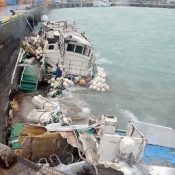
September 14, 2017 Ryukyu Shimpo Digital Edition
Two Taiwanese fishing boats had drifted to the Hirara Port in Miyakojima City as a result of typhoon No. 18.
On September 14 at 8:57 am, four crew members who had been stranded on one of the boats were rescued by the Miyakojima Maritime Safety Agency.
There were no reported injuries. At the same time, an oil spill was also confirmed at the port.
Of the two boats, one had partially sunk.
The two boats had arrived at the port on the evening of September 12 to take refuge from the typhoon. A total of 10 Taiwanese and Indonesian crew members remained on the boats. In the afternoon of September 13, they had called for help because the mooring rope had almost snapped.
Six crew members had already been rescued, but the other four had still been stranded due to the
(English translation by T&CT and Chelsea Ashimine)
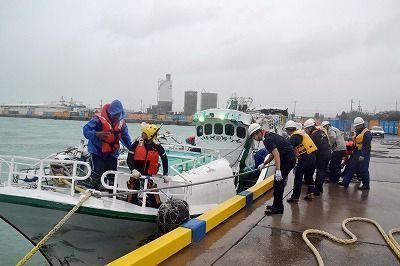
Maritime Safety Agency members (right) pulling the Taiwanese fishing boat that had been adrift toward the shore on September 14, 9:04 am in Miyakojima City.
Go to Japanese

September 18, 2017 Ryukyu Shimpo
Okinawan-born singer Namie Amuro celebrated the 25th anniversary of her debut performance with back-to-back performances dubbed “Namie Amuro 25th Anniversary Live in Okinawa” on September 16 and 17 at Ginowan Seaside Park in Ginowan.
Over the two days combined, as many as 52,000 fans flocked to the standalone concert in Okinawa to lose themselves in Amuro’s crystal clear singing voice and dancing.
Amuro sang a total of 27 songs, including her Super Monkey’s-era debut “Mister U.S.A.,” the chart-topping “Don’t wanna cry,” and “NEVER END,” which became the theme song for the Kyushu-Okinawa summit.
Tomie Naito (31), originally from Haebaru, who raced back to Okinawa from Osaka to see the show said, “Everytime I see her, her impressive dancing and singing voice is overwhelming.
As a fellow Uchinanchu, I look up to her.”
A similar 20th anniversary concert was planned in Okinawa five years ago, but was cancelled due to an encroaching typhoon.
Regarding the chance to have the anniversary concert this time around, Amuro commented, “So many fans came to the venue.
I am grateful that I was able to have the concert on the day of my debut.”
(English translation by T&CT and Sam Grieb)
Go to Japanese
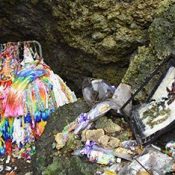
September 16, 2017 Ryukyu Shimpo
On September 15, the Kadena Police arrested four boys aged between 16 and 19 for vandalizing the Chibichiri Gama cave in Namihira, Yomitan where residents were forced to commit mass suicide during the Battle of Okinawa.
According to the police, the teens have admitted to the offence.
The arrested are three unemployed youths, aged 16, 18, 19, and one construction worker, aged 17.
They have been charged with damage to property including two warning sign boards, four bundles of senbazuru (one thousand origami cranes) and one plaque between around 12 p.m. on September 5 and around 11 a.m. on September 12.
On September 15, the Chibichirigama Bereaved Families Association filed a claim with the Kadena Police Station.
Norio Yonaha, head of the Bereaved Families Association, said when he filed the claim, “The bereaved relatives are shocked and hurt.
Chibichirigama is a place of learning about the past and connecting generations.
This action is not allowed. We would like the police to find out why this happened in order to prevent such an action again. ”
According to the Kadena Police Station, some of the arrested boys alleged that they had gone to “a haunted spot” to “test their courage.”
On the morning of September 10, the arrested visited the cave with other teens, travelling on motorcycles.
All the teens except the four facing charges tried to stop the vandalization of the cave.
(English translation by T&CT)
Go to Japanese
G0 to Japanese
September 14, 2017 Ryukyu Shimpo
It is impossible to forgive the desecration of the victims of the Battle of Okinawa and their surviving families by destroying a memorial site that conveys the true face of war.
The interior of and entrance to Chibichiri-gama, a natural cave in Namihira, Yomitan where Okinawan civilians were driven to commit mass suicide during the Battle of Okinawa, was vandalized.
Bones, bottles and pottery from the time of the Battle of Okinawa, and other remains in the cave were scattered across the ground. Paper cranes, folded by middle and high school students who visited the cave for peace education tours from all over Japan, were torn apart, and the stones of the “peace statue connecting generations” were damaged. The monument to the song of Chibichiri-gama, written by sculptor Minoru Kinjo, and the no-entry sign in front of the cave were toppled.
The “peace statue connecting generations” was damaged once before, by members of a right-wing organization in 1987.
One can see why the head of the survivors’ association said that the victims have been killed thrice—during the Battle of Okinawa, at the time of the incident thirty years ago, and again, now.
We hope the perpetrators and their motives are uncovered with haste.
On April 1, 1945, the United States military landed on Okinawa Island. On the same day, two youths were badly injured by machine gun fire when they exited Chibichiri-gama holding bamboo spears to face the U.S. soldiers.
An interpreter for the U.S. military called out to those in the cave, “We won’t kill you, so come out,” but the civilians, believing they would be killed brutally if they were captured by the U.S., instead fled deeper into the cave.
The next day, April 2, when the U.S. military arrived, a Japanese soldier who had previously fought in China piled up futons and blankets inside the cave and set them on fire.
Evacuees in the cave used injections of poison and sickles, knives and other sharp objects to kill each other.
During wartime, the Japanese military indoctrinated everyone, even civilians, to believe that if they were taken prisoner by the enemy, they must either kill at least one enemy soldier before being killed themselves, or else die by their own hands.
The Japanese military roused people’s fears by telling them that men captured by the U.S. military would be run over by tanks, and women would be raped and then killed.
Anyone who surrendered to the U.S. military was considered a traitor. Those who actually attempted to surrender were killed by Japanese soldiers.
According to a document of news, propaganda and counterintelligence guidelines for instructing Okinawans during the war, the 32nd Army had a policy under which the military, government officials and civilians were to live and die together, and Okinawan civilians were to be “instructed, guided and convinced” to die together with the Japanese military before being captured by the United States.
The History of Okinawa Prefecture tells us that Chibichiri-gama was cut off from the outside world, and those inside at the time had an extreme sense of isolation, feeling that they were the only ones left alive.
The civilians in the cave were driven to commit mass suicide because of coercion and instruction on the part of the Japanese military, which required that even civilians die.
Chibichiri-gama is a symbol of the harm caused to Okinawan residents by the Japanese military during the Battle of Okinawa.
Masaie Ishihara, emeritus professor at Okinawa International University, speculates that the vandalism likely occurred because the cave was targeted as a result of garnering attention as a place for conveying Okinawa’s “nuchi du takara” philosophy of peace.
It is deeply troubling that the cave has once again been subjected to violence. Nothing can come of violence.
(English translation by T&CT and Sandi Aritza)
Go to Japanese
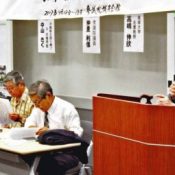
September 14, 2017 Ryukyu Shimpo
Tokyo – The “Committee to enact the 9/29 Okinawan Citizens Festival resolution,” which is working to restore in history textbooks the compulsory nature of the group suicides in Okinawa at the end of World War 2, held a symposium marking the 10th year since the Citizens Festival, as well as a photo exhibit related to the forced mass suicides, on September 13 at the National Diet.
The symposium took on the atmosphere of a protest in the wake of the vandalism at Chibichiri Gama cave in Yomitan, where the Japanese military forced the Okinawan citizens taking refuge in the cave to commit suicide en masse at the Battle of Okinawa, with appeals such as, “This vandalism is unforgivable.”
The appeals decrying the vandalism stated that Chibichiri Gama is, “a place containing the lost memories of people whose lives were taken in an extremely abnormal way,” and voiced their anger against the cowardly vandal who refuses to come forward nor make their intention known.
The symposium was paneled by Kiku Nakayama, who lived through the Battle of Okinawa as one of the Shiraume corps of student nurses, Nobuyoshi Takashima, professor emeritus at the University of the Ryukyus and expert on the textbook screening process, moderator Kasuga Nakanishi from the resolution realization committee, and Representative Toshinobu Nakazato (Independent).
Nakanishi said that there was a factual error regarding Okinawa’s economy in the high school textbook published by Teikoku-shoin, which was pointed out and corrected.
“It was because we were engaged in the 9/29 movement that we were able to stop it. It drives home the importance of engaging in these activities to ensure the truth is printed.
” Nakanishi also noted that textbook accounts of the Battle of Okinawa only include the Himeyuri Student Corps, and that “I want them to at least include the fact that all the women’s schools had student corps, and it is a shame that it has not happened.”
Professor Takashima stressed that the will of the Okinawan people has overcome the interference and pressure of the textbook screening process.
Representative Nakasato, who led the executive committee for the 2007 Okinawa Citizens Festival, said, “The origin of ‘All Okinawa’ was the citizens festival.”
(English translation by T&CT and Sam Grieb)
Go to Japanese
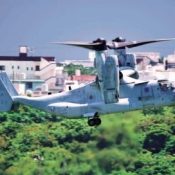
September 10, 2017 Ryukyu Shimpo
An MV-22 Osprey vertical takeoff and landing aircraft made an emergency landing at Oita Airport while traveling between MCAS Iwakuni and MCAS Futenma, where it is based.
At 1:13 p.m. on September 9 it returned to Futenma. The aircraft from which smoke and flames were seen rising flew in the sky over Okinawans’ heads both before and after its emergency landing, and following replacement of its engines.
On August 29 the Osprey at hand landed at Oita Airport while en route from MCAS Iwakuni to MCAS Futenma.
Directly after landing, smoke and flames were seen on the aircraft.
While at Oita Airport the right and left engines were both replaced, but once more on September 7 smoke rose from the aircraft.
The next morning the Osprey was taken on a test flight to MCAS Iwakuni.
Past 11:00 a.m. on September 9 the Osprey departed from MCAS Iwakuni, and two hours later arrived at MCAS Futenma.
Upon landing at Futenma the aircraft had taxied itself to a parking apron and continued to run its propellers for about 10 minutes, during which time American soldiers crowded around the aircraft.
The Okinawa Prefectural Government, Ginowan City, and other concerned municipal governments received an ex post facto report from the Okinawa Defense Bureau.
Local sentiment calling for the halt of Osprey flights has been ignored, even in light of the recent crash off the coast of Australia and cases of emergency landings.
As such, voices opposing flights of these aircraft in Okinawa have spread. No information on the cause of the emergency landing or other details had been announced as of September 9.
This Osprey was the same one that made an emergency landing at Iejima Auxiliary Airfield in June this year.
Smoke rose from the aircraft on August 28 as well, as confirmed by a citizen’s photograph taken at MCAS Iwakuni.
(English translation by T&CT and Erin Jones)
Go to Japanese
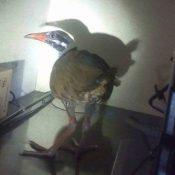
September 8, 2017 Ryukyu Shimpo
By Ayako Sakaguchi
Yanbarukuina or Okinawa rail, which is an endangered species and designated as a natural treasure of Japan suddenly appeared in the house of Mitsuaki Miyagi in Takasato, Ogimi Village. While Yanbarukuina are sometimes found in the gardens of private residences in Yasuda, Kunigami Village, it is rare for them to be found inside homes.
Miyagi expressed his surprise; “I have lived in the same house for 68 years and this is the first time this has happened. I was very excited.”
A Yanbarukuina came into the house around 2:30 p.m. on July 18.
Miyagi was sitting on the sofa in the house, watching TV.
One Yanbarukuina walked past the front of the television and then hit the screen door.
When Miyagi got up from the sofa, the rare bird hid in the gap behind the television.
From the color of its beak, it appeared to be an infant bird born this year.
Miyagi released the bird back into the forest behind his house.
The bird ran away quickly. When it came into the house, the back door had been left open.
(English translation by T&CT and Megumi Chibana)
Go to Japanese

September 7, 2017 Ryukyu Shimpo
With a message of love, courage, and excitement, the Super Miracle Illusion Kinoshita circus in Okinawa will be held from December 15 as a launch event for the Ryukyu Shimpo main building.
The Kinoshita circus is one of the three biggest circuses in the world and the biggest group in the country with a long history and tradition dating back to its establishment 115 years ago.
It has been five years since the group last performed in Okinawa.
The group is known for creating a spectacle with dynamic shows featuring masters’ techniques developed over the circus’s history.
It is also famous for its world-leading talent and prestigious performers from various countries.
The circus presents a range of excellent entertainment that fill audiences with excitement such as the miraculous fierce animal show starring a very rare white lion and female lions, the Death Defying Motorcycle Globe show, the double flying trapeze 15 meters above the ground, and much more.
The programs entertain all ages, from children to elderly.
Information:
Performances will be held from December 15, Friday to February 26, Monday at the Toyosaki Town Special venue in Tomigusuku city. The stage will be closed every Thursday except for January 4, New Years Eve, January 10 and February 14.
Tickets are available for 2600yen for adults and 1600yen for kids (aged three years old to middle school years).
For more details, please contact the Ryukyu Shimpo office at 098 (865) 5200.
The office is open on weekdays from 10am to 5pm.
(English translation by T&CT and Sayaka Sakuma)
Go to Japanese
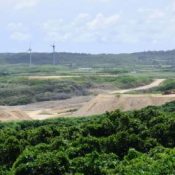
September 7, 2017 Ryukyu Shimpo
(Miyako) Interviews with multiple government officials revealed, on September 6, that the “Bora mine” in Bora, Gusukube, Miyako is being eyed as a likely candidate for an ammunition depot to store missiles as part of the plan to deploy Japan Ground Self-Defense Force (GSDF) troops to Miyako Island.
The Ministry of Defense was also considering a golf course in the same area of Bora as a possible location for the ammunition depot, but at the request of Miyako residents supporting the GSDF deployment plan, the Bora mine was chosen as the most likely candidate.
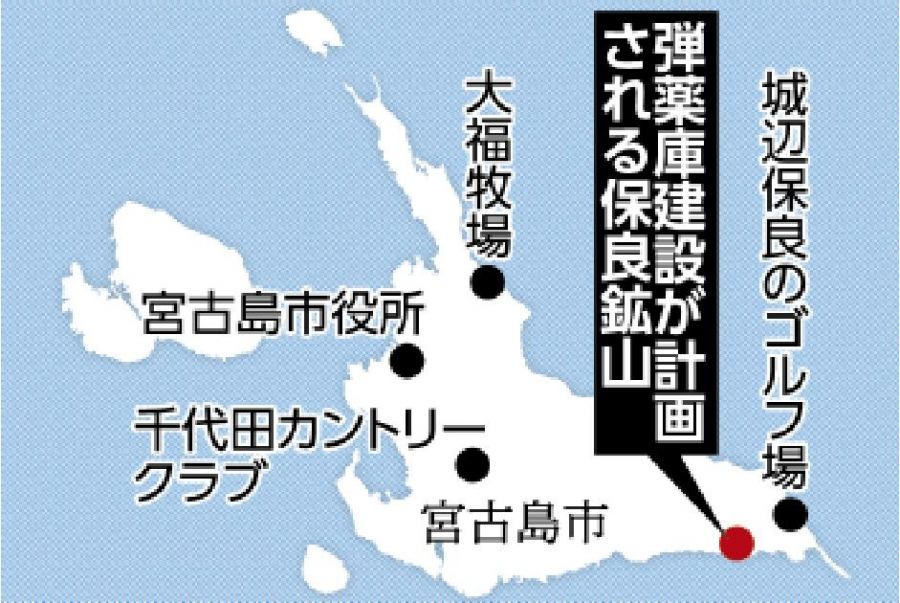
The Ministry of Defense plans to officially announce the ammunition depot location after the Miyako city council election
at the end of October, in order to avoid the announcement having any impact on the outcome of the election.
The operator of the mine and the head of Bora village have not yet expressed an opinion on the matter, and it is
possible that local attitudes could impact the progress of the plan.
Originally, the Ministry of Defense planned to build a JSDF base including an ammunition depot near the Daifuku farm in Hirara, Miyako.
However, that area is a groundwater conservation zone, and the plan was abandoned because of opposition by Miyako Mayor Toshihiko Shimoji, who had concerns about its impact on groundwater resources.
According to multiple government officials, the mine is located outside the groundwater conservation zone and comprises more than 6,000 square meters.
The landowners are the family of the mine operator and are relatively few in number, so the government anticipates little trouble in negotiating the sale of the land.
Meanwhile, the Ministry of Defense was also considering the golf course in Bora, Gusukube as a possible location for the ammunition depot.
However, a Miyako group supporting the GSDF deployment opposed this proposal, expressing concerns that closing two golf courses in Miyako (including the Chiyoda golf course) could impact tourism demand in the winter months.
Takeo Sunagawa, president of Miyako Sogo Kaihatsu, the company that operates the mine, said, “I hadn’t heard anything about this and I am very surprised.
I haven’t thought at all about how to respond.” Tatsuo Sunagawa, head of the Bora village association, said, “We have not been approached regarding the matter.
I can’t say anything now, but [the Ministry of Defense] would need to hold an information session for us first and foremost.”
(English translation by T&CT and Sandi Aritza)
Go to Japanese












 Webcam(Kokusai Street)
Webcam(Kokusai Street)


